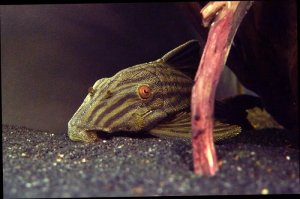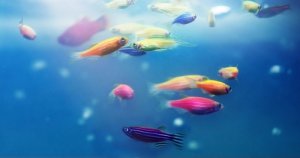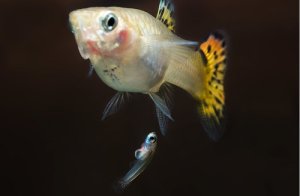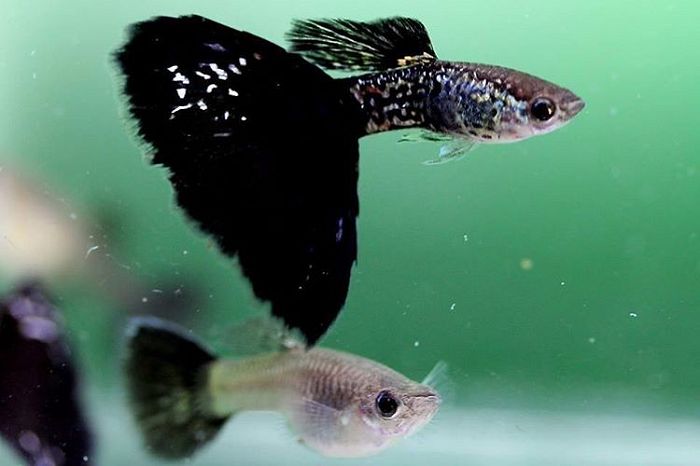
The Guppy is by far the most popular freshwater tropical fish usually chosen by beginners and similarly enjoyed by more experienced aquarists. The Cobra guppy is one of the most unique and intricate color variation types of guppies that you will find, with snake-like patterns similar to that of the cobra. It comes in many colors and different print varieties, and there is no single cobra guppy that is the same, so yours will be the only of its color design.
Cobra guppies, like any other guppy, are easy to care for, and a hardy, peaceful shoaling fish, provided that they are kept under good conditions. Guppies do have quite specific needs that we will address and explain as we go along, but before we get into that let’s first look at the species and color variations of the Cobra Guppy.
Breed Overview
| Origin | Mostly South America. |
| Lifespan | 1-3 years, 5-year maximum. |
| Size | Males 1.5– 3.5cm (0.6 – 1.4 Inches), Females 3–6 cm (1.2–2.4 Inches). |
| Colors | Cobra Pattern in Green, yellow, Red, Dragon, Lemon, Golden, Luminesce, Koi, and Leopard. |
| Food | Omnivore. |
| Tank Size | 10 – 20 Gallons, and 5 gallons per additional fish. |
| Temperament | Active, Peaceful, Shoaling. |
| Water Temperature | 78–82°F (25.5–27.8°C). |
| Water pH | 6.5 – 8.5 Brackish Water. |
| Difficulty Level | Beginner Easy, and ideal for advanced Enthusiasts. |
Species Summary
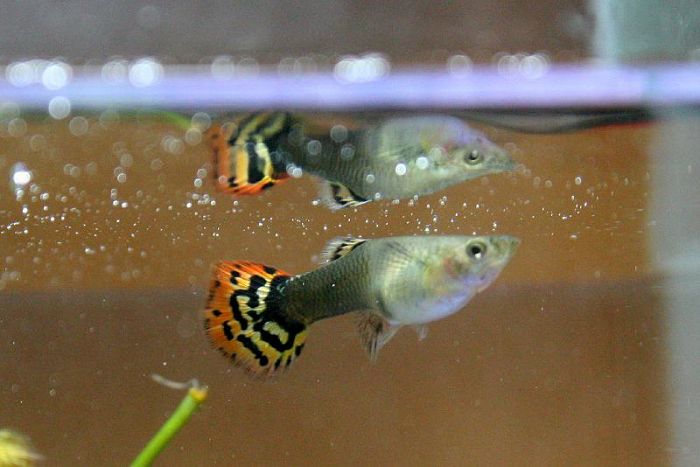
The guppy (Poecilia reticulata), as a species, is one of the world’s most popular freshwater aquarium fish that originated in South America and is now found all over the world. Guppies are hardy and tolerant fish that can survive in both freshwater and saltwater. They are much loved for their peaceful and social nature, and tendency to shoal.
The Cobra Guppy is an extremely exceptional color variation of this ornamental aquarium fish, with color imprints so unique that not a single one is the same. Moreover, the Cobra guppy has a diverse range of color morphs and combinations that are intricate and fascinating. So, before we get into the facts, we will first move on to the main types of Cobra Guppies
Color Variations Of Cobra Guppies
The Guppy fish species have been bred for over a century to create the most extraordinary and extreme color variations. Guppies in the wild and captivity are generally classified according to their eye color, body color, and shades as well as their tail shape. However, Cobra Guppies have earned special recognition within the fishkeeping community, because of their unique color mutations.
The Guppy is divided into three sub-categories pertaining to variations;
- Base Color – The Four Base colors include Albino, Cobra, Wild-Color, and Blond. Ground Colors may also be formed from combinations of the basic colors.
- Tail Type – There are ideally 12 different tail shapes in guppies as seen in the diagram from Wikipedia;
| Larger Strain: | Sword Strain: | Shorter Strain: |
|
|
|
- Patterns – The Cobra Pattern is a rosette-type pattern on the skin resembling that of a cobra snake, with vertical bars. Then, there is the Carpet pattern, Snakeskin Pattern, and Black or “Tuxedo” pattern.
The Most prominent varieties of the Cobra Guppy are;
- Green – Green-yellow color.
- Cobra – Black and orange.
- Yellow – Black and Yellow.
- Red – Red to Green Color with black.
- Dragon – Blue to red with Yellow.
- Lemon – Light yellow, green.
- Golden – Yellow Gold color.
- Koi – Red, Orange, and White.
- Leopard – Yellow with black.
- Luminous – Available in Assorted Colors.
Sexual Dimorphism In Guppies
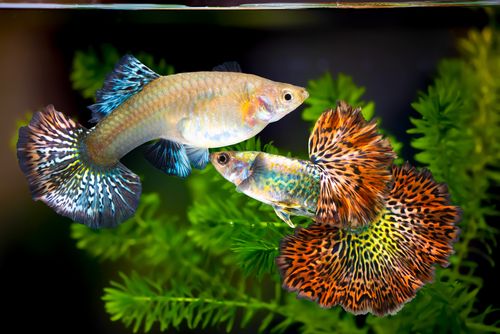
Guppies are one fish species that is the easiest to differentiate between males and females, as they have unique qualities. Female Guppies are almost twice the size of males, and whereas the male has a streamlined, slender boy, the female has a much rounder, chunkier body.
Males are more extravagant in color, and have larger tails, while the female is less colorful with a short tail and slight indications of specific color variations.
Although many other species of fish are almost impossible to know the sex, guppies are unique in that there are a lot of differences between the males and the females.
Guppy Fish Lifespan And Size
Most Guppies will only live for around 1-3 years, especially ornamental guppies, though with the finest care, they can live up to 5 years. A fully grown male guppy will be around 1.5– 3.5cm (0.6 – 1.4 Inches), and a female 3–6 cm (1.2–2.4 Inches).
Temperament And Behaviour
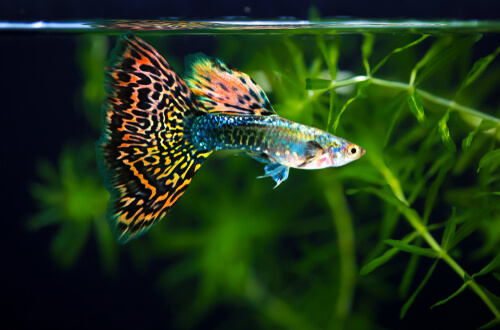
Guppies are shoaling fish and therefore will need a companion or two, preferably one male with two or three females. They are mostly Peaceful, and get along well with other tank mates. Guppies are said to be quite energetic and social, with friendly personalities, and individuality.
Overall Care Of Cobra Guppies
Caring for guppies in general is fairly easy as they are hardy and tolerant fish, which is the same case with Cobra guppies, making them the perfect choice for beginners, and more advanced Guppy enthusiasts.
We will start with a suitable, relaxed habitat for your guppies first;
The Aquarium For Your Cobra Guppies
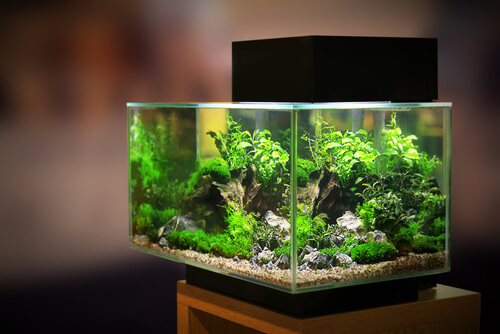
When creating a habitat for our guppies, you want something where they will be content, and that will show off their intricate, bold colors and confident personalities. We will try to mimic these conditions as they naturally occur in tropical climates, in streams and pools, with more brackish water.
- Tank Size – A tank of between 10-20 gallons will suffice for three guppies, with an additional 5 gallons per guppy, or a similar-sized tank mate.
- Water Conditions – Cooler tropical temperatures of 78–82°F (25.5–27.8°C) are suitable. Guppies prefer Brackish water, so add 1 tablespoon per 5 gallons of water. Keep your water pH between 6.5 and 8.5, and ensure the water is always clean. You will need a thermometer and testing kit to do parameter checks.
- Filtration – Invest in a very gentle hang-on back, or sponge filter that has a light current, and that will keep the water clean, and oxygenated.
- Light – Guppies need 8-10 hours of sleep at night because they have a circadian rhythm. Keep them in indirect sunlight, or use an LED lamp during the day.
- Heat – Unless you stay in a warm tropical climate, their water temperatures should never be below 68 ̊ F(20 ̊ C), so a small heater may be needed.
Decorating Your Tank
- Substrate – Mostly fine sand, gravel, or crushed coral is a suitable substrate for guppies and gives you a basis to plant live plants.
- Ornaments And Toys – Depending on the theme or style of your tank, use ornaments that provide hiding space, and entertainment for your guppies. Anything from castles, shipwrecks, caves, ceramic pots, and PVC pipes, to more natural rocks and driftwood, and plenty of live or synthetic plants.
Live Plants
I mostly recommend Live plants in aquariums because they are softer and less prone to injuring your fish, they clean your tank and provide oxygen. Plants can also be a tasty snack for most fish and other tank habitats. Likewise, we are trying to simulate their natural habitat. Thus, here are a few excellent plant choices for your Guppies;
- Java Moss
- Flame Moss
- Ball of algae
- Anacharis
- Water Sprites
- Water Wisteria
- Barteri, Wrinkle Leaf Cognesis, or Hastifolia Anubias
- Guppy Grass
- Water Lettuce
- Amazon Swords
- Moneywort
- Cryptocoryne
- Hornwort
- Java Ferns
New Guppies For Your Aquarium
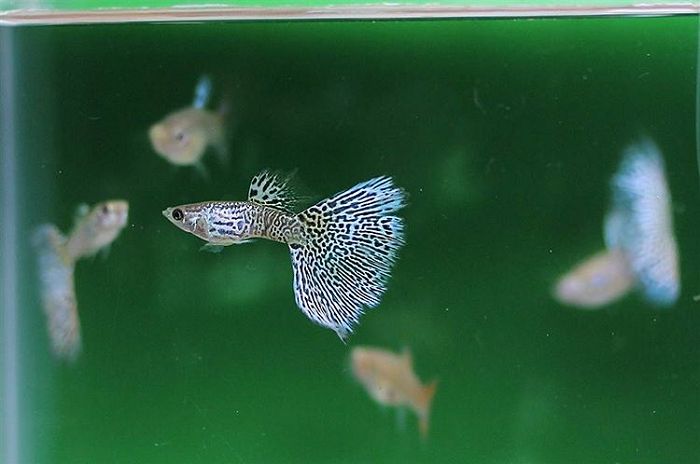
With many different colors and types of Cobra guppies available, you may have found your favorite by now. There are many reputable breeders, and pet stores that specialize in ornamental fish breeds from whom you may inquire, as you may not find the fancy Cobra guppy in your regular pet stores that easily.
Before choosing any fish, ensure that they are healthy and active, showing no signs of damage or disease, with a clear and colorful body and bright eyes. You will need to choose a few guppies, as they are Shoaling fish, and require some companions.
Place your fish in the bag to float in your aquarium for 20 minutes to acclimate. Then you can replace cup by cup of the bag water with the tank water at 10-minute intervals for another 20 to 30 minutes. Now your fish should be used to the water conditions, and content to be introduced into their new home.
The Best Guppy Tank Mates
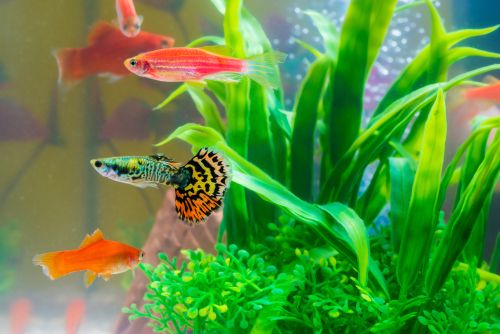
Other Fish that are similar in size and peaceful themselves will make ideal tank mates. You will similarly need to consider whether they will be suited for the water conditions preferred by guppies.
Here is a list of some of the most suitable tank mates for your Guppies;
Smaller Shoaling Fish
- Endler’s Livebearers
- Platy Fish
- Black Neon Tetras
- Ember Tetras
- Chili Rasboras
- Galaxy Rasboras (Celestial Pearl Danio)
- Harlequin Rasboras
- White Cloud Minnows
- Peacock Gudgeons
- Molly Fish
Small Bottom Feeders
- Otocinclus Catfish
- Pygmy Cory Catfish
- Kuhli Loaches
- Bristlenose Plecos
Invertebrates
Invertebrates also make good tank mates for guppies. Consider adding the following species to your guppy tank for even more variety:
- Cherry shrimp
- Amano shrimp
- Nerite snails
- Cherry Shrimp
Feeding Cobra Guppies
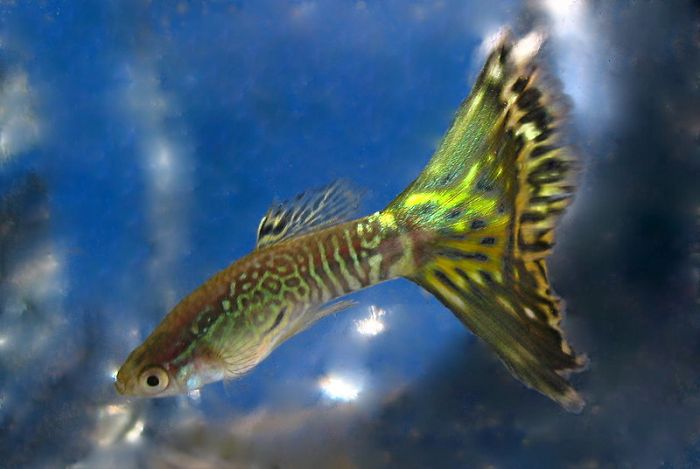
Cobra Guppies similar to all Guppy species are omnivores requiring a balanced diet of both plant and meat matter. They are quite slow eaters and require at least 30 to 60 minutes to finish their food, after which all food matter must be removed, if not eaten by bottom-dwelling companions. Guppies can be fed in the mornings and late afternoon before bedtime.
Guppy Foods
- Meat Based – Small insects and larvae such as mosquitos, Brine shrimps, Daphnia, Bloodworms, and cooked minced beef or egg yolk can be given for protein. brine Shrimp, Daphnia, Cooked Minced Beef, Cooked egg Yolk, detritus, Insect larvae, Mosquitos, and Bloodworms.
- Plant-Based – Guppies can ideally eat a variety of vegetables including; cucumber, peas, lettuce, algae, zucchini, Broccoli, Cauliflower, kale, and spinach. All vegetables need to be blanched and cooled down before feeding.
- Staple – Guppies should mainly be fed a staple of good quality nutritious, and balanced flakes or granules daily.
Tank Maintenance
Not something we all look forward to, but a vital part of owning fish is maintaining your tank and regular cleaning. Your filter, plants, and algae cleaning habitats should do most of the work for you, however, you also need to maintain and keep the tank and ornaments clean and free from decaying plant matter, foods, and algae build-up as far as necessary.
Weekly water changes are vital;
- Remove at least 20-30% of the tank water siphoning it from the bottom.
- Prepare water separately and condition it with aqua salts to get the right parameters.
- Use water that is the same temperature as that of your tank.
- Replace the water with fresh water that has the same parameters and temperatures as your tank.
Common Pests And Diseases In The Cobra Guppy
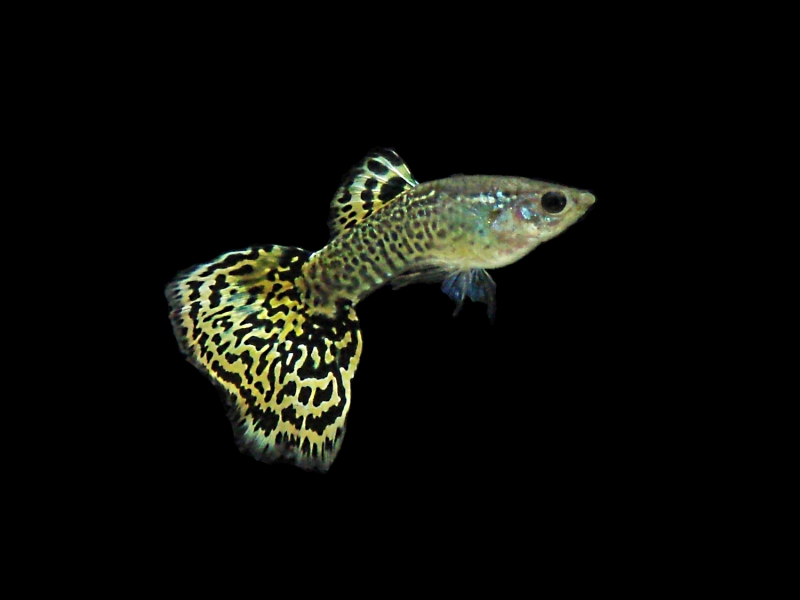
Guppies are relatively hardy fish that seldom get sick. Though poor water conditions, poor diet, stress, and contagious pests or disease from new plants or fish may lead to some issues.
Most conditions in guppies can easily be treated by quarantining your sick fish in a separate tank with optimal water conditions, and a higher temperature. Medication for the specific condition or antibiotics for infection may be obtained from a vet or pet store.
The Most common pest and diseases in guppies are;
- White Spot Disease/Ich – A parasite that causes white spots on your fish.
- Fin And Tail Rot – Ammonia Burns or dirty water causes an infection that will cause the fins and tail to appear ragged and patchy.
- Swim Bladder Disorder / Dropsy – Infection or damage to the swim bladder, that allows the fish to be buoyant. It can cause your fish to be bloated and swim irregularly, struggling to stay upright.
- Columnaris & Mouth Fungus – Contagious bacteria that causes cloudy splotches on the mouth and middle part of the body.
- Gill Flukes – Mainly found in Guppies, it is a worm that attacks the gills of your guppy, causing difficulty breathing. It can be treated in the early stages with quarantine, as it is infectious, and medication. Though when the gills start bleeding, it is too late.
You will find much more in-depth information on Guppy Diseases and Pests in our article “Guppy Fish Behaviour Before Death”.
Breeding In General
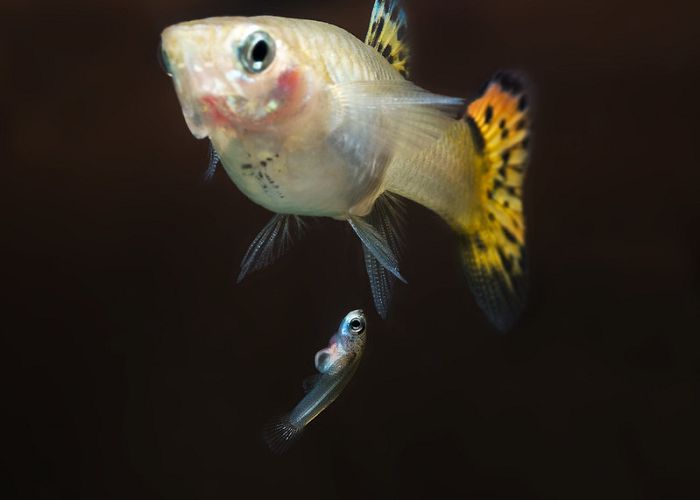
Cobra Guppies, like all other guppies are live-bearing fish, with intricate mating rituals, and birthing methods. One very notable aspect of guppies is that they are eager breeders and they mature quite fast, you may soon find a few small fries in your tank.
Unfortunately, in a communal tank where the parents are present and other Live bearing fish, your young fry is at risk of being eaten by both. Guppies are cannibalistic towards their own young to put it politely. Thus, the ideal breeding setting for guppies is to have a separate tank for controlled mating, with color variations of your choice, and where you can remove the parents after the birth of the fry. Unless you want to allow nature to take its course in your guppy’s initial aquarium.
As you will notice, males tend to chase females around non-stop during mating season, and that is why we recommend keeping either, one male per two to three females, or only females. Keeping only males can be risky, but not impossible.
If breeding your guppies is something that you would be interested in I highly recommend reading “How to Do Guppies Mate”
Final Thoughts
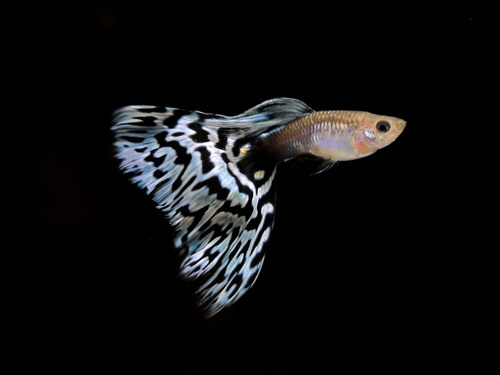
The Cobra Guppy will be a colorful and stimulating addition to your established aquarium, or a hardy and beginner-friendly option for your new aquarium. The peaceful and entertaining fish species, with individual personalities, will ensure many hours of social antics, and funny quirks.
With the right care, and by following our guidelines, you should have some years with a healthy and flourishing cobra guppy and companions.


